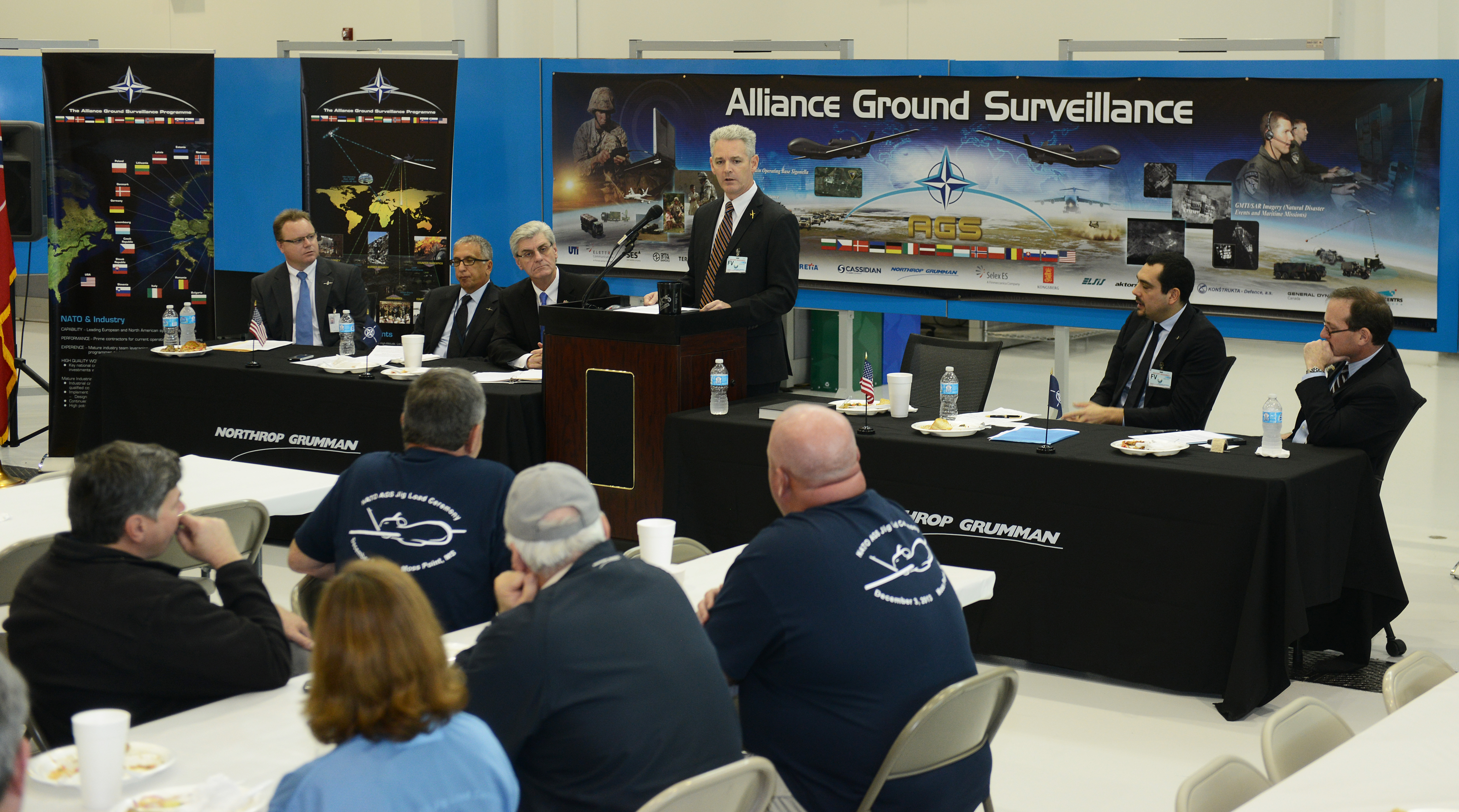As a trusted leader in global security solutions, Northrop Grumman has a strong and broad portfolio of unmanned systems and mission technologies that have been delivered to customers worldwide for nearly 70 years. From sea, ground, air and space, the company invests in solutions that meet customer demands, improve mission effectiveness and reduce costs by advancing technologies in key areas such as autonomy, systems integration, mission and information management, software, sensors and training.
Northrop Grumman is one of the leading sponsors for the premiere unmanned systems exhibition hosted by AUVSI, where the company has a number of unmanned systems and supporting equipment on display.
Highlighted programmes include BAT, Common Mission Management System (CMMS), EURO HAWK, FIREBIRD, FIRE SCOUT, GLOBAL HAWK, Heterogeneous Airborne Reconnaissance Team (HART), James Webb Space Telescope, NASA GLOBAL HAWK, NATO AGS, MQ-4C TRITON, HUNTER, SANDSHARK, and X-47B UCAS.
Land systems include the Remotec robotic platforms and sub-systems (including the ANDROS Unmanned Ground Vehicle (UGV) line-up available for EOD, Hazmat, tactical, CBRNE, tactical and military use), and the CaMEL (Carry-all Modular Equipment Landrover).
Electronic Systems on display include AESA radars, common infrared, countermeasures, cosite mitigation device, LN-251 INS/GPS, AN/AQS-24A Airborne Minehunting System, AN/APR-39 radar, warning receiver, STARLite and VADER radars.
In 2013, Northrop Grumman Corporation launched CUTLASS, its latest generation unmanned ground vehicle (UGV), expanding its range of industry-leading capabilities in unmanned systems for the remote handling and surveillance of hazardous threats. CUTLASS has been designed, developed and manufactured by Northrop Grumman in the UK, and includes significant advances in technology and performance and a range of features that provides state-of-the-art capabilities for national security and resilience applications.
Northrop Grumman will build five additional US Navy MQ-8C FIRE SCOUT unmanned helicopters, which allow ship commanders to extend their intelligence-gathering capabilities far beyond the horizon.
 |
| A MQ-8C FIRE SCOUT unmanned helicopter sits at Naval Base Ventura County at Point Mugu, CA, where flight testing of the system is conducted. (Photo: NG/Alan Radecki) |
"Land-based flight tests of the system are progressing well and we're working with the Navy to conduct our first ship-based flights this summer," said George Vardoulakis, vice president, medium range tactical systems, Northrop Grumman. "We expect the MQ-8C FIRE SCOUT will be ready for operations by year end."
The MQ-8C can remain on station for more than eight hours and supporting long-duration missions, thus requiring less aircraft to sustain operations. A total of 19 aircraft are under contract with the Navy. FIRE SCOUT uses on-board sensors to capture full-motion video, identify targets and distribute information in real time to various users. This allows ship-based commanders to maintain awareness of a specified area or keep an eye on a target of interest for long periods of time.
The US Air Force RQ-4 GLOBAL HAWK unmanned aircraft system (UAS) has completed a series of ground and air demonstrations at Beale Air Force Base, CA, expanding the adaptability of the GLOBAL HAWK system to use an additional Satellite Communications (SATCOM) link to improve the transfer of mission data.
At the request of the US Air Force Air Combat Command, Northrop Grumman worked with Air Force partners to demonstrate that GLOBAL HAWK is compatible with different SATCOM architectures with no changes to the aircraft's hardware, software or payload. Taking place from Jan. 13-15, the demonstration highlighted a unique split link capability for GLOBAL HAWK that allows it to send mission data through a satellite link that is independent of the link used for command and control.
"This powerful demonstration illustrates GLOBAL HAWK's unique versatility," said Alfredo Ramirez, director and chief architect of Northrop Grumman's HALE Enterprise. "We're ecstatic with GLOBAL HAWK's ability to provide intelligence, surveillance and reconnaissance products to operational end-users via multiple paths."
The combat-proven GLOBAL HAWK has logged more than 110,000 flight hours and carries a variety of intelligence, surveillance and reconnaissance sensor payloads to allow military commanders to gather near real-time images and uses radar to detect moving or stationary targets on the ground or at sea. The system supports antiterrorism, antipiracy, humanitarian assistance, disaster relief, airborne communications, and information sharing missions.
Northrop Grumman's Moss Point, MI Unmanned Systems Center started production of the first NATO Alliance Ground Surveillance (AGS) Block 40 GLOBAL HAWK aircraft, enhanced to meet NATO operational requirements.
NATO representatives, state dignitaries, community leaders and Northrop Grumman employees gathered to celebrate the start of production for the first of five aircraft. The system will provide NATO with unprecedented near real-time terrestrial and maritime situational awareness information throughout the full range of NATO military and civil-military missions, including peacekeeping and humanitarian relief operations. The NATO AGS system will be a major contribution to NATO's joint intelligence, surveillance and reconnaissance (ISR) capability.
"The variety of sensors and ability to support a wide range of missions will revolutionize how NATO collects ISR," said Jim Edge, general manager, NATO AGS Management Agency. "It was an honor to witness the start of production for the first NATO aircraft, and I'm excited at being one step closer to delivering the AGS system."
The NATO AGS system will be equipped with the multimode Multi-Platform Radar Technology Insertion (MP-RTIP) airborne ground surveillance radar sensor to provide all-weather, day or night intelligence to the NATO Alliance. The system also includes an extensive suite of network-centric enabled line-of-sight and beyond-line-of-sight long-range, wide-band data links.
The NATO AGS system also includes European-sourced ground assets that will provide in-theater support to commanders of deployed forces. Mobile and transportable ground stations will provide an interface between the AGS core system and a wide range of interoperable NATO and national command, control, intelligence, surveillance and reconnaissance systems. NATO is acquiring the system with 15 nations participating including Bulgaria, Czech Republic, Denmark, Estonia, Germany, Italy, Latvia, Lithuania, Luxembourg, Norway, Poland, Romania, Slovakia, Slovenia, and the United States.
The NATO Alliance Ground Management Agency awarded the prime contract for the system to Northrop Grumman in May 2012 during the NATO Summit. The company's primary industrial team includes EADS Deustchland GmbH (Cassidian - mow Airbus Defence & Space), Selex ES, and Kongsberg, as well as leading defense companies from all participating nations.
The NATO AGS system is a variant of the combat-proven GLOBAL HAWK, which has logged more than 100,000 flight hours and has supported operations in Iraq, Afghanistan and Libya. The system has also collected weather data in support of scientific missions and participated in humanitarian relief efforts after the devastating natural disasters in Haiti, Japan and the Philippines.
 |
| NATO AGS at Sigonella Artist Concept |







No comments:
Post a Comment